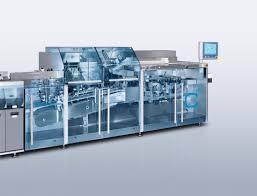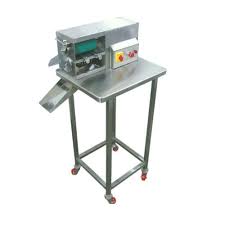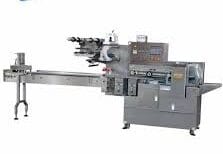|
Getting your Trinity Audio player ready... |
Understanding the Strip Packing Machine: A Comprehensive Guide
Strip packing machine: A strip packing machine is a highly efficient and fast machine primarily used in the pharmaceutical and other industries to package a wide range of products such as capsules, coated tablets, tablets, soft gelatin capsules, and more. It plays a pivotal role in modern packaging processes, especially for unit-dose medicines, ensuring that the products are safely sealed and protected from external environmental factors. Below, we will explore the details of strip packing machines, comparing them with blister packing machines, discussing their benefits, limitations, and applications, and looking into the various components that make up a strip packing machine.
What is Strip Packing?
Strip packing is a packaging process where products are placed between two heat-sealable films, which are then sealed together by a strip packing machine. These films are generally made of materials such as aluminum, plastic, or a combination of both. The machine forms individual units by sealing the product within pockets of these films, which can be easily separated for consumption or use. The sealed film protects the products from environmental factors such as air, moisture, and light, ensuring their safety and extending their shelf life.
Comparison of Strip Packing and Blister Packing Machines
When it comes to packaging pharmaceutical products, two of the most commonly used methods are strip packing and blister packing. Although they may appear similar, there are key differences between the two that make each method suitable for specific applications.
- Mechanism of Packaging
- Blister Packaging: In blister packaging, the product is placed in pre-formed cavities or blisters, typically made through a process called thermoforming or cold forming. These cavities hold the product securely and are usually sealed with a backing material such as aluminum foil or plastic. Blister packing machines typically offer more mechanical protection to the product as they create a strong enclosure around the product.
- Strip Packaging: In contrast, strip packaging involves enclosing the product between two layers of heat-sealable films, without the formation of cavities. The films are sealed by the strip packing machine using a reciprocating platen or a heat crimp roller. The product is typically placed in a linear arrangement on the film, and the machine seals the product in place.
- Speed and Production Rate
- Blister Packaging: Blister packing machines generally operate at a higher speed compared to strip packing machines. They can handle larger volumes of products in less time due to the more automated process of forming and sealing blisters.
- Strip Packaging: Strip packing machines are slower than blister packing machines, as they require more precise handling and sealing of each individual unit. The process of placing products between two films and sealing them without the creation of cavities makes it a more labor-intensive process.
- Protection and Durability
- Blister Packaging: Blister packs offer better protection in terms of mechanical strength, as the formed cavity shields the product from external pressure and impacts. This makes blister packaging ideal for delicate products that require extra care.
- Strip Packaging: While strip packaging offers good protection from environmental factors like moisture and air, it doesn’t provide the same level of mechanical protection as blister packaging. However, it is more child-resistant due to the nature of how the product is enclosed and removed.
- Ease of Product Removal
- Blister Packaging: Products in blister packs can be easily removed by pushing or peeling the backing away. This is often seen as a convenient feature for patients and consumers.
- Strip Packaging: Products in strip packs are removed by tearing the pack along the perforations. While this may be a little more cumbersome than blister packs, it does provide an added level of security.
- Visual Appeal
- Blister Packaging: Blister packaging is more visually appealing because the product is clearly visible through the transparent cavity, making it more attractive to consumers.
- Strip Packaging: Strip packaging doesn’t allow for the same level of visibility, making it less appealing to consumers who like to see the product before purchasing.
Benefits of Using a Strip Packing Machine
There are numerous advantages to using a strip packing machine for packaging pharmaceutical products. Below are some of the key benefits:
- Cost-Effective Solution
Strip packing machines offer an economical solution, especially when packing highly sensitive products. The materials used in strip packaging are often less expensive than those used in blister packaging, making it a more budget-friendly option for packaging pharmaceuticals.
- User-Friendly
Strip packing machines are relatively easy to operate. They often come with intuitive controls and user interfaces that simplify the operation for packaging staff. This ease of use can lead to more efficient production lines and increased output.
- Product Protection
The airtight pockets in strip packaging help reduce exposure to environmental factors such as light, moisture, and oxygen, all of which can compromise the quality of the product. This level of protection helps maintain the potency and shelf life of sensitive products like pharmaceuticals.
- Improved Dosage Accuracy
One of the major advantages of strip packaging is that each tablet, capsule, or soft gel is individually sealed in a pocket, making it easier for patients to keep track of their medication. This ensures that the correct dosage is taken at the right time, which is critical for effective treatment.
- Durability
Strip packaging materials are typically strong and durable, ensuring that the seal remains intact during transport and storage. This helps to prevent damage to the product and ensures the integrity of the packaging over time.
Limitations of Strip Packing Machines
While strip packing machines offer several benefits, there are also limitations that should be considered when deciding whether this is the right packaging method for your products.
- Space Requirements
The seals produced by strip packing machines take up a significant amount of space, which means that the packaging boxes for these products need to be larger. This may lead to higher storage and shipping costs.
- Popularity
Strip packing has become less popular in recent years, with many manufacturers opting for blister packaging due to its more robust protective qualities. As a result, strip packing may not be as widely used or recognized in the market.
- Product Damage Risk
Because strip packing does not provide the same level of mechanical protection as blister packs, there is a higher risk of product damage due to perforations or wrinkles in the sealing material. This could affect the product’s integrity and its appeal to customers.
- Consumer Appeal
Consumers are generally more likely to purchase products in blister packs because they can see the contents inside. This visual appeal is not present in strip packaging, which may make it less attractive to consumers.
- Usability for Elderly or Disabled Patients
Accessing the product in strip packaging can be challenging for elderly patients or those with limited dexterity, such as people with arthritis. The need to tear the packaging can be difficult for some individuals, making blister packs a more practical choice for this demographic.
Other Pharmaceutical Packaging Solutions
In addition to strip packaging, there are several other packaging methods commonly used in the pharmaceutical industry:
- Blister Packaging
As mentioned earlier, blister packaging forms a cavity around the product, offering strong mechanical protection and visibility for the consumer. It is widely used for tablets, capsules, and other solid forms of medication.
- Bottle Packaging
Bottle packaging is used for liquids, tablets, capsules, and other pharmaceutical forms. Glass is often used for bottle packaging due to its excellent barrier properties, and bottles are typically colored to protect the contents from UV light.
- Vial Packaging
Vials are small containers, usually made of glass or plastic, used to store liquids, powders, or capsules. Vials can be reused and sterilized, making them a cost-effective option for storing certain types of medications.
- Sachet Packaging
Sachet packaging is a flexible, sealed pouch commonly used for powders, small quantities of liquids, and single-dose products. They are typically used in the food and pharmaceutical industries.
- Syringe Packaging
Syringe packaging is used for injectable medications. These syringes are pre-filled with a single dose of the medication and are sealed to ensure sterility.
- Ampoule Packaging
An ampoule is a small sealed container used to store pharmaceutical products that are sensitive to air and light. Ampoules are typically used for unstable compounds and are sealed with heat, making them ideal for storing volatile substances.
Factors Affecting the Price of a Strip Packing Machine
The price of a strip packing machine can vary depending on several factors:
- Competitors
The pricing strategy of competing manufacturers can influence the price of a strip packing machine. A highly competitive market can drive prices down.
- Production Capacity
Machines with higher production capacities generally cost more due to the added complexity and automation required for high-volume production.
- Manufacturer
The reputation, experience, and quality of the manufacturer play a significant role in determining the price of a strip packing machine. Well-established manufacturers may charge a premium for their products.
- Automation Level
Machines with higher levels of automation tend to cost more due to the increased functionality and efficiency they offer in production.
- Materials
The construction materials used for the machine, such as stainless steel, can also impact its price. Higher-quality materials tend to result in higher costs.
Understanding the Operation of a Strip Packing Machine
A strip packing machine is widely used in various industries to pack products efficiently and securely. This includes pharmaceuticals, food products, and other sensitive items. The machine is designed to seal products in strips of packaging material, typically between two layers of foil or plastic, ensuring the goods remain intact and protected until they reach the consumer.
Before beginning operation with a strip packing machine, the first step is to ensure that the machine is powered on. Once the machine is ready, the products to be packed are placed on the feeder tray, where they are moved to the conveyor belt for further processing. The conveyor belt operates in a uniform pattern to ensure that each product is positioned correctly for sealing.
At this point, a roller comes into play, ensuring that the products are laid flat and aligned properly for the sealing process. The products continue their movement along the conveyor belt, reaching the sealing station. At the sealing station, the product is positioned in alignment with the sealing material, which will be applied to secure the package.
The packing material holder then releases the packaging material through the packaging shaft. This material moves vertically into position where the machine applies the sealing material. The process involves two strips that seal the product, and these strips are fused together through a heat press or pressure mechanism.
Once the sealing process is complete, a cutter comes into action, cutting the product at regular intervals to create uniform packages. Finally, the sealed products exit the sealing station and move toward the gutter system, completing the packing process.
Different Types of Strip Packing Machines
There are several types of strip packing machines available, each designed to cater to different needs and requirements within various industries. Here are some of the most commonly used machines:
- Alu-Alu Strip Packing Machine
The Alu-Alu strip packing machine is primarily used in the pharmaceutical industry, especially for packaging highly sensitive medicines, such as those that are hygroscopic (absorb moisture) or light-sensitive. This machine ensures that these products are securely packed between two aluminum foil sheets, which offer superior protection from moisture, UV rays, oxygen, and other environmental factors that may degrade the product.
Key industries using this machine include:
- Chemical Industry
- Pharmaceutical Industry
- Food Industry
Alu-Alu machines are also capable of packaging small items such as ball bearings, pins, and buttons. The benefits of Alu-Alu packaging include:
- High thermal stability.
- Impressive thermo-formability.
- Reliable anti-counterfeit features.
- Complete barrier protection against light, water, and gases.
- Foil Strip Packing Machine
This versatile machine is capable of sealing products between two layers of foil, providing airtight packaging that preserves the integrity of the contents. It is suitable for packaging a wide range of products at high speeds (up to 2400 items per minute). It also features a perforation and cutting system to ensure uniformity in packaging.
Some key features of the foil strip packing machine include:
- Punch frequency: 40 to 80 times per minute.
- Capacity: 800 pieces per minute.
- Power requirement: 0.75 kW.
- Stainless steel construction for durability.
- Tablets Strip Packing Machine
This machine is specifically designed for packing tablets of various sizes, including effervescent, coated, and uncoated tablets. Tablets are oriented flat on the conveyor to ensure proper sealing. The machine offers flexibility in packaging different tablet types, ensuring that each product is securely sealed in its strip.
Some examples of tablets this machine can package include:
- Effervescent tablets.
- Coated tablets.
- Dispersible tablets.
- Chewable tablets.
- Lozenges.
- Capsules Strip Packing Machine
Designed for packing capsules of varying sizes, this machine is highly efficient and ensures accurate packaging. The capsule strip packing machine offers adjustable features for different types of capsules, and it ensures that each product is sealed with precision.
Key features of the capsule strip packing machine include:
- Voltage options: 220v or 380v.
- Air pressure: 0.4 MPa.
- Maximum packing width: 260 mm.
- Double Aluminum Strip Packing Machine
This type of machine uses two layers of aluminum for packing and is known for its efficiency and low noise operation. It is also equipped with a Programmable Logic Controller (PLC) to automate various processes like filling, sealing, counting, and cutting.
Key features include:
- Stainless steel body for durability.
- PLC for automated control.
- Transducer-controlled motor speeds, allowing for precise adjustments.
- PP Strip Packing Machine
Polypropylene (PP) is used as a lightweight and adjustable sealing material. The PP strip packing machine is easier to operate and handles lighter materials better than other, heavier packaging materials such as steel. It is a low-noise machine, making it ideal for environments where noise reduction is a priority.
- Manual Strip Packing Machine
As the name suggests, this machine requires manual operation and is often used in smaller pharmaceutical and food industries where automation is not yet a necessity. It operates with one sheet of foil and requires more human involvement during the process, making it less efficient than fully automatic machines. However, it is more affordable and is suited for smaller-scale production.
- Automatic Strip Packing Machine
The fully automatic strip packing machine handles all the essential functions of the packaging process without human intervention. These functions include:
- Cutting.
- Printing.
- Material feeding.
- Counting.
- Waste disposal.
The machine is controlled via a human-machine interface (HMI) and a programmable logic controller (PLC), making it easy to operate and update. This type of machine is ideal for industries that require high-volume, efficient, and reliable packaging solutions.
Features to Look for in a Strip Packing Machine
When selecting a strip packing machine, several factors should be taken into consideration to ensure that the machine meets the specific requirements of your production process. Key features to evaluate include:
- Material of the body: The machine should be constructed from durable materials such as stainless steel for reliability and longevity.
- Speed: The speed of the machine will determine how many items it can pack in a given time.
- Packaging material width: Ensure that the machine can handle the specific packaging material required for your products.
- Machine weight and size: These factors will influence how the machine fits into your existing production setup.
- Power supply requirements: Make sure the machine is compatible with the power infrastructure in your facility.
- Production capacity: Choose a machine that can handle your production needs, whether you’re working on a large or small scale.
- Quality compliance: The machine should comply with industry standards for quality and safety.
Troubleshooting Common Issues in Strip Packing Machines
Like any machinery, strip packing machines may experience issues during operation. Here are some common problems and their solutions:
- Machine has no power: Ensure that the machine is plugged in, the power switch is on, and that there is power to the machine.
- Substandard sealing: This can be caused by faulty voltage or improper contact with the sealing material. Check and repair the switch to avoid voltage fluctuations.
- Film out of place: Re-align the film to the spindle and check if the tracking system is working. If not, repair or replace it.
- Irregular cutting: Ensure the blades are sharp and positioned correctly.
Safety Features of Strip Packing Machines
Safety is paramount when operating strip packing machines. Some safety features that are commonly found in these machines include:
- Defect detection sensors: These sensors automatically detect and reject defective strips from the good batch.
- Automatic shutdown sensors: If a foreign object is detected, the machine will automatically shut down to prevent further damage.
- Alarm system: An alarm will sound if the machine malfunctions or is not operating correctly.
- Fireproof electrical systems: To ensure safety in case of electrical issues, strip packing machines are equipped with fire-resistant systems.
Uses of Strip Packing Machines
Strip packing machines are primarily used in the pharmaceutical and food industries. They are designed to pack products such as tablets, capsules, soft gelatin capsules, and more. These machines ensure that products are securely sealed, maintaining their integrity and shelf life.
What is a Strip Defoiler Machine?
A strip defoiler machine is used to recover tablets or capsules from defective foils. It separates the foil from the products and comes with adjustable slitters to facilitate this process.
Strip Designs in Strip Packing Machines
The design of the strips is an essential consideration when using a strip packing machine. Most designs feature rectangular or square strips, while pocket portions can be round, square, or oval, depending on the product’s shape. The size and shape of the pockets depend on the dimensions of the items being packed.
Quality Control During the Strip Packing Process
Quality control is crucial to ensure that only properly sealed strips move forward in the production process. Many strip packing machines are equipped with sensors that detect defects and ensure that only high-quality products make it to the next stage of packaging.
Maintenance of Strip Packing Machines
To maintain the efficiency and longevity of a strip packing machine, regular maintenance is required. This includes:
- Replacing worn-out or broken parts.
- Inspecting and replacing faulty electrical components.
- Performing regular checks on sensors to ensure accurate packaging.
- Using genuine parts from reliable manufacturers to minimize breakdowns.
In conclusion, strip packing machines play a critical role in modern manufacturing, ensuring products are securely packed and protected throughout their journey from production to the consumer. By understanding the types of machines, features, troubleshooting techniques, and maintenance practices, you can optimize the use of a strip packing machine and keep your production line running smoothly.
Conclusion
Strip packing machines are an essential part of modern packaging processes, especially in the pharmaceutical and food industries. They offer several benefits, including cost-effectiveness, ease of use, and protection for sensitive products. However, they also have limitations, particularly in terms of mechanical protection and ease of access for consumers. Understanding the advantages and disadvantages of strip packing compared to other methods, such as blister packaging, can help manufacturers make informed decisions about the best packaging solutions for their products. Additionally, considering factors like price, production capacity, and material quality will ensure that the right strip packing machine is chosen to meet specific packaging needs.















